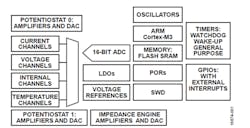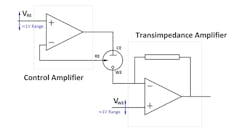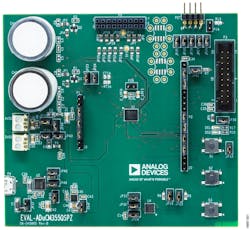IC Tackles Interface Idiosyncrasies of Biological-/Chemical-Sensing Probes
Providing the interface circuitry for the sensors of physical parameters is a major role undertaken by many analog-circuit designers. However, even experienced engineers doing sensors for basics such as temperature, pressure, or position may be unfamiliar with the highly specialized probe arrangements that are standard in electrochemical sensing. These require potentiostat and electrochemical impedance spectroscopy (EIS) functionality to properly assess characteristics of solutions widely used in “wet chemistry” analysis.
To simplify the interface design and provide high-accuracy results, Analog Devices has introduced the ADuCM355 precision analog front end plus microcontroller for applications such as industrial gas sensing, instrumentation, vital-signs monitoring, and even disease management (Fig. 1).
1. The ADuCM355 for potentiostat-based chemical-solution assessment provides not only the sophisticated, precision analog front end, but also an advanced microcontroller for function management, security, and I/O—all at extremely low power.
The company claims that this highly integrated, single-chip device also has the most advanced sensor diagnostics, best-in-class low-noise and low-power performance, and smallest form factor of available approaches, which presently require multiple devices for comparable performance. Furthermore, it’s the only solution available that supports the basic dual-sensor potentiostat designs as well three- and four-sensor electrode implementations. The IC goes beyond being an analog interface, though—it includes a microcontroller based on the Arm Cortex-M3 processor specially designed to control and measure chemical and biosensors.
Sensor Specifics and the PGSTAT
In potentiostatic mode, a potentiostat/galvanostat (PGSTAT) controls the potential of the counter electrode (CE) (sometimes referred to as the auxiliary electrode, AE) versus the working electrode (WE), to ensure that the potential difference (voltage) between the WE and a reference electrode (RE) equals a user-specified value (Fig. 2).
2. This simplified, high-level block diagram of a potentiostat shows the relationship among the three electrodes and the circuitry needed for their analog input and output. (Source: Yihan Zhang, Columbia University)
In galvanostatic mode, the current flow between the WE and the CE is controlled. In a complete design, the voltage between the RE and WE and the current flow between the CE and WE are continuously monitored and controlled by a closed-loop, negative-feedback mechanism.
Just two electrodes are used in a basic measurement configuration, with the “chemistry of interest” at the WE; the CE functions as the other half of the cell, completing the circuit and maintaining a constant interface potential regardless of current value. However, it’s difficult to simultaneously maintain a constant CE potential as current is flowing, and compensate for voltage drop across the chemical solution itself.
To overcome those problems, the three-electrode approach of WE, CE, and RE is used (in some special configurations, a fourth electrode is added). The entire arrangement is somewhat analogous to using 3- or 4-wire Kelvin sensing to measure voltage across a load resistor or at contact points while eliminating the effects of contact resistance and IR drop in leads.
Among its features, the ADuCM355 offers:
- Voltage, current, and impedance measurement
- Dual ultra-low-power, low-noise potentiostats: 8.5 µA, 1.6 µV RMS
- Flexible 16-bit, 400-ksample/s measurement channel with advanced sensor diagnostics
- Integrated analog hardware accelerators
- 26-MHz core, 128-kB flash, 64-kB SRAM
- Security/safety via hardware crypto accelerator with AES-128/AES-256; hardware CRC with programmable polynomial generator; and read/write protection of user flash
- Two precision voltage references
- UART, I2C, and SPI serial input/output; up to 10 GPIO pins; external interrupt option; and general-purpose, wakeup, and watchdog timers
The IC is housed in a 6- × 5-mm, 72-lead LGA package and operates from a single 2.8- to 3.6-V supply. In hibernate mode, but with bias to external sensors, it requires just 8.5 µA while current drain in full shutdown mode is 2 µA. It’s fully specified for −40 to +85°C ambient operation and priced at $5.90 each in 1000-piece lots. The EVAL-ADUCM355QSPZ kit (Fig. 3) uses a PC plus USB connection so that users can evaluate the performance of the ADuCM355 across a range of different electrochemical techniques.
3. The PC-based, USB-linked EVAL-ADUCM355QSPZ kit lets users evaluate the ADuCM355 in various electrochemical techniques, including chronoamperometry, voltammetry, and electrochemical impedance spectroscopy.
References
Metrohm Autolab B.V, Autolab Application Note EC08, “Basic overview of the working principle of a potentiostat/galvanostat (PGSTAT) – Electrochemical cell setup”.
The Analytical Sciences Digital Library, “Analytical Electrochemistry: The Basic Concepts”.
University of Notre Dame, The Prashant Kamat Laboratory, “Potentiostat”.
About the Author

Bill Schweber
Contributing Editor
Bill Schweber is an electronics engineer who has written three textbooks on electronic communications systems, as well as hundreds of technical articles, opinion columns, and product features. In past roles, he worked as a technical website manager for multiple topic-specific sites for EE Times, as well as both the Executive Editor and Analog Editor at EDN.
At Analog Devices Inc., Bill was in marketing communications (public relations). As a result, he has been on both sides of the technical PR function, presenting company products, stories, and messages to the media and also as the recipient of these.
Prior to the MarCom role at Analog, Bill was associate editor of their respected technical journal and worked in their product marketing and applications engineering groups. Before those roles, he was at Instron Corp., doing hands-on analog- and power-circuit design and systems integration for materials-testing machine controls.
Bill has an MSEE (Univ. of Mass) and BSEE (Columbia Univ.), is a Registered Professional Engineer, and holds an Advanced Class amateur radio license. He has also planned, written, and presented online courses on a variety of engineering topics, including MOSFET basics, ADC selection, and driving LEDs.




